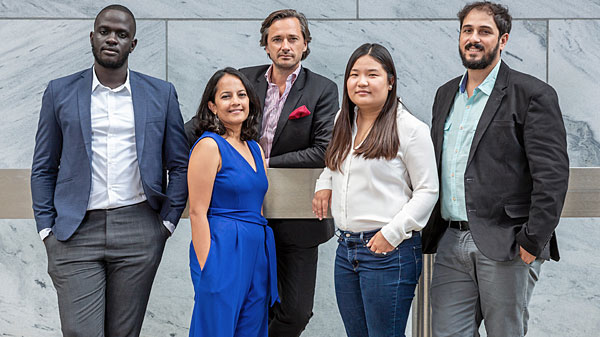Legendary watchmaker Rolex recently took over the iconic Smithsonian American Art Museum in Washington DC for a truly special event – the awards ceremony announcing the five newest recipients of its biennial Rolex Awards for Enterprise. Launched in 1976, the awards were designed to foster the spirit of enterprise in worthy causes ranging from protecting and cultivating the environment and humanity’s cultural heritage to advancing human knowledge and well-being.

In line with the haute horology house’s long-standing commitment to preserving the world around us, the Rolex Awards will now stand as a central pillar in its newly-announced Perpetual Planet campaign, a project aimed at supporting key individuals and organisations worldwide in creating solutions to the world’s myriad environmental challenges.

As recipients of the 2019 Rolex Awards for Enterprise, the five new Laureates not only received considerable funding for their various humanitarian and conservation projects as well as a global platform from which to promote their causes, but also walked away with a Rolex chronometer of their very own.
“These are not achievement awards,” proclaimed Rebecca Irvin, Rolex’s head of philanthropy, “They are awards for people who are on the verge of doing something really important.”
WINNERS OF THE 2019 ROLEX AWARDS FOR ENTERPRISE

Miranda Wang
Canadian molecular biologist Miranda Wang has been passionate about solving the plastic waste problem since her school days. Her company, BioCellection, has developed a groundbreaking process that transforms unrecyclable single-use plastics into valuable chemicals for the manufacturing industry. Demonstrably proven to have the same quality as products made from virgin oil, her process also notably reduces carbon dioxide emissions that would result from plastics being dumped or burned.
Next, Wang hopes to develop a fully commercial processing plant utilising this innovative method, a move she predicts will recycle 45,000 tonnes of plastic waste by 2023, thereby eliminating 320,000 tonnes of carbon dioxide emissions.

Grégoire Courtine
French medical scientist Grégoire Courtine has found a solution to help paralysed individuals walk again via an innovative, minimally-invasive treatment that implants an electronic “bridge” implanted between the brain and the spine. Through wireless technology, the neuroprosthetic bridge can restore immediate voluntary control over leg muscles, and has successfully rehabilitated several patients.
Courtine will now embark on a new clinical trial with three paralysed patients, one that will implant a newly-upgraded brain-spine bridge to allow independent control of the neural signals without use of external technology. If successful, it could be expanded to treat other sufferers of spinal-cord paralysis.

Krithi Karanth
Violent clashes between India’s rural farmers and native wildlife populations are all too common. Clashes over limited resources and space often result in damages and death on both sides – including those of endangered tigers, elephants and leopards. While the Indian government does provide compensation, many remain unaware of this provision. That’s where conservation scientist Krithi Karanth comes in. Her approach to mitigating human-wildlife tension is to help those affected – especially the illiterate – in filing for compensation. She has also implemented educational initiatives to increase awareness among the next generation.
Now, she wants to expand her programme to three more national parks and 1,000 more villages, using mobile technology to identify conflict hotspots, and field-test anti-wildlife measures to keep people and their livestock safer.

Brian Gitta
Over 220 million people suffer from malaria each year, resulting in nearly 500,000 fatalities. It’s a tragedy made sadder by the reality that malaria is curable disease if diagnosed promptly. That is the aim of Ugandan IT specialist, Brian Gitta. Current tests require a blood sample, equipment and a trained technician. However, Gitta’s team has developed the Matiscope portable electronic device, capable of bloodlessly diagnosing malaria in under two minutes by detecting any magnetic residue in the blood shed by the malaria parasite.
Gitta now hopes to improve the Matiscope’s diagnostic accuracy to at least 90 percent, while also convincing medical professionals and patients that his non-invasive technology is a cheaper and more efficient means of testing, one that could transform Africa’s war against malaria.

João Campos-Silva
The world’s largest scaled freshwater fish – the giant arapaima – is on the brink of extinction. Long a staple food source to native Amazonians, overfishing, habitat fragmentation and other human impacts have decimated its population. However, Brazilian fisheries biologist João Campos-Silva is determined to reverse this process, while also helping increase quality of life for the indigenous human inhabitants. To that end, he has partnered with locals to foster careful fishery management practices that have yielded an amazing 30-fold increase in arapaima numbers.
Now, Campos-Silva hopes to upscale his model of wildlife conservation to a 2,000km stretch of the Juruá River, a southern tributary of the Amazon River, while also improving the lives of the 60 communities inhabiting that area.
Text: Tenzing Thondup



